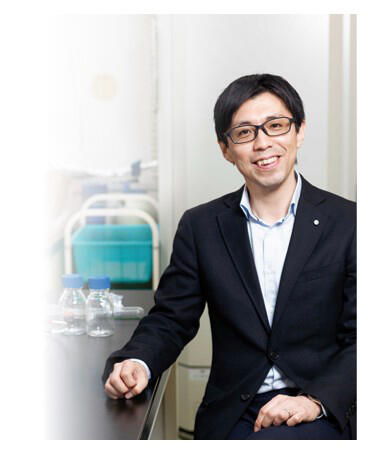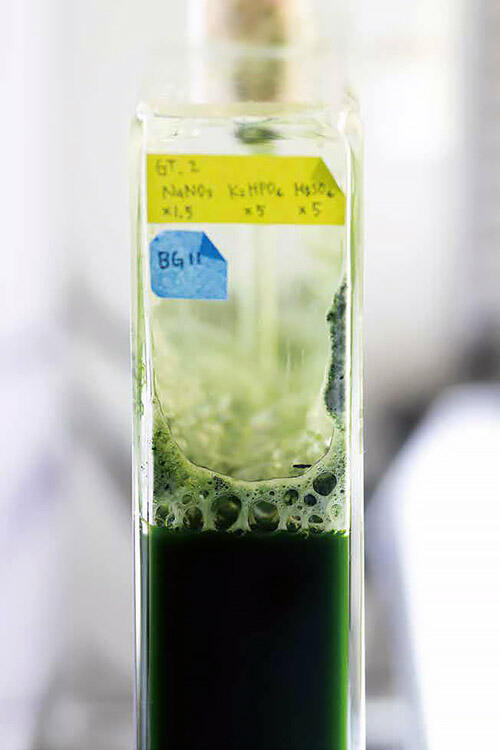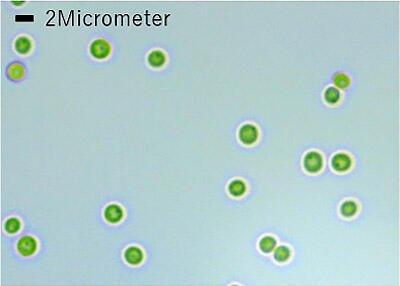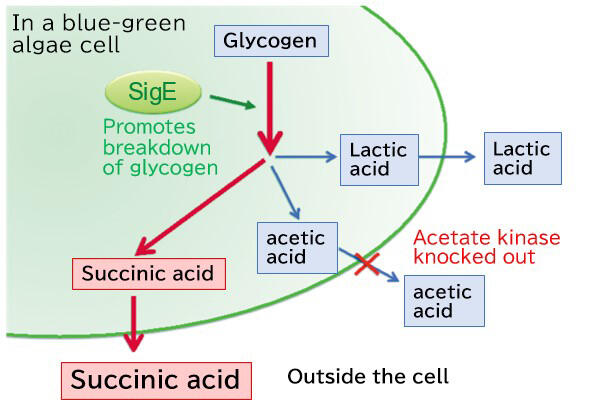Takashi Osanai, Associate Professor at the School of Agriculture at Meiji University is working to realize a low-carbon society by producing plastics from carbon dioxide using cyanobacteria, a group of bacteria, which perform photosynthesis. In addition to publishing a number of papers with his students, he also actively engages in collaboration with private companies, being successful in continuously producing successful outcomes.

Associate Professor, School of Agriculture, Meiji University
Researcher of PRESTO between 2011-2014, project leader at ALCA since 2013
In a series of happy coincidences, succinic acid generated from CO2 and water
Plastics are a group of useful materials, but cause many environmental problems such as marine plastic pollution. There are also concerns about the depletion of oil, used for plastics. Research related to bioplastics, therefore, have boomed in recent years due to their lower environmental impact.
Conventional bioplastics can be made from substances such as edible sugars and oils. Takashi Osanai, Associate Professor at the School of Agriculture, Meiji University , is attempting to use one of these substances with a simple structure, CO2, as a raw material for plastics. He explains the intent of his research, "As the population increases in the future, sugars and oils will be prioritized for human consumption. If CO2 derived from the air is used for plastics, it would solve the resource depletion issue and also help to reduce the level of CO2, a cause of global warming."
As a PRESTO researcher since 2011, Dr. Osanai has worked on a research project involving the production of polyhydroxybutyrates (PHBs), a raw material for bioplastics, within cyanobacteria (Fig. 1, Fig. 2). Cyanobacteria accumulate PHBs within their cells and Dr. Osanai discovered a chemical(s) to cause excretion of these outside the cells for industrial use.


Looking for a useful substance naturally excreted from the cells, Dr. Osanai discovered in 2013 that the cyanobacteria excrete succinic acid, a chemical used for bioplastics. He recalls, "Later, we found most cyanobacteria do not produce succinic acid, but Synechocystis, the one I used in my research, was rare for being able to produce succinic acid. In addition, the analysis equipment I used at the time was able to detect the succinic acid clearly. In the same year when I discovered the cyanobacterial succinic acid production, my project was accepted by ALCA (Advanced Low Carbon Technology Research and Development Program) for a research grant related to low carbon technology. All I can say is, this research began as a series of happy coincidences."
Constant awareness of cost performance
A win-win relationship with companies
Cyanobacteria generate glycogen from CO₂ by photosynthesis and accumulate it within the cells. In a dark environment where photosynthesis is not possible, cyanobacteria break down the glycogen to generate energy, while acetic acid, lactic acid and succinic acid are released from the cells as byproducts.
In 2015, by manipulating the cyanobacterial genomes, Dr. Osanai succeeded in increasing the amount of succinic acid released by five-fold (nearly 100 mg per liter), and in 2020, he raised the succinic acid levels to 1 g per liter (Fig. 3). Emphasizing the importance of cost consciousness, Dr. Osanai explains, "It may be the current world record, but for a practical application, you would need to increase the succinic acid levels more than 50 g per liter. No matter how great the scientific results, no company will adopt it if it is not cost-effective. For commercialization purposes, succinic acid levels must be produced with large volumes, and/or in combination with values adding products"

In a collaboration with euglena Co., Ltd. (Minato City, Tokyo), Dr. Osanai discovered in December 2016 that succinic acid could be produced from Euglena, also known as "midorimushi" , or green bug in Japanese. In October 2020, he succeeded in increasing the succinic acid levels to 1.5 g per liter. In December 2018, he also discovered that amino acids could potentially be obtained from Euglena, and in October 2020, he found out that acidifying the culturing solution of the Euglena would generate high levels of glutamic acid and glutamine.
Dr. Osanai engages in wide collaboration with several companies, and he thinks that this is the secret to all his success: "It is vital to have a mutually beneficial relationship when you engage with a company. Rather than simply concluding a project to my own satisfaction, I am always aware of the need to obtain results meaningful to both parties."
Students choose their own research problems to tackle
Balancing between research results and self-realization
His lab students take charge of the collaborative research with these companies. Sixty to seventy percent of the lab students are recruited after graduation from their university. Collaboration with the companies provides excellent career development opportunities for the students. In terms of the benefits, Dr. Osanai says, "Students who engage in the work of developing actual products and get first-hand experience of the approach required for work, such as promptness in response and action, and the required level of product changes their mindset. They grow immensely not just as researchers, but also as people."
For students hoping to study at the graduate school, Dr. Osanai encourages them to write their international papers from an early stage. Research into a field of biology takes time, and thus, fewer students have opportunities to write research papers than in other disciplines. Dr. Osanai himself struggled to complete his first paper. He stresses the importance for students to come up with findings as early as possible, explaining, "When students complete their first paper early, they get a good view of what it takes to advance research and find it easier to take the next step."
Sometimes, when a research topic does not produce expected results, Dr. Osanai might give up on it early. Changing the topics, he considers the view of the students and explains various choices for research topics, and let the students choose them on themselves. The process of changing research topics can also fuel their growth.
Dr. Osanai explains the vibrancy of his lab, "Fortunately, the early students in my lab made a great effort to finish their papers. Therefore, we have fostered a good atmosphere where even undergrads can write their papers, so graduate students write papers as a matter of course." He devotes himself every day to ensuring that his students are coming up with research achievements but can also realize their potential and develop themselves personally.
Extending personal networks and setting high goals for a long research career
In the PRESTO program, Dr. Osanai has developed a wide network through overnight camp-style research conferences and research briefing sessions. He focuses on the basic research and works hard in friendly competitions with his fellows in the same age group. This is what led him to apply for ALCA. He explains that in ALCA, which focuses on the application and social implementation of research, he acquired the habit of not just being satisfied with what he had achieved but setting higher goals for his research through numerous strict interim evaluations. When it comes to developing and broadening the scope of your research, he notes, "Being selected is not the goal. The important thing is how much you can improve yourself after you were selected. In my case, in addition to improving my own research, I actively engage in a range of activities, which let me to be introduced to researchers in other disciplines or different funding programs. If you can expand your personal and information networks, that will surely lead to new opportunities."
Answering to the question about his next objective, Dr. Osanai notes, "Retirement is at 70 in my university, so it is vital to be able to continue to do research for a long time without getting sick of it." He analyzes himself as a person who is easily bored, but at the same time, he says, "Researchers are people who find interesting aspects in things of which others find no interest. As I think that I have an eye for uncovering interesting things, I intend to always be on lookout for them."
Looking at Dr. Osanai's research record, he has clearly taken a varied approach across a range of fields of interest from basic science to application, and his research has always been anchored in the metabolic mechanisms in living things. His interest now lies in the "fusion of biology and chemistry," says Dr. Osanai. He lights up as he speculates that there must be even more materials that could be generated by cyanobacteria. We will follow his work, which aims to achieve a low carbon society into the future.




